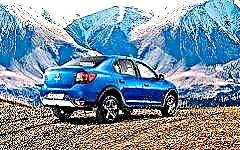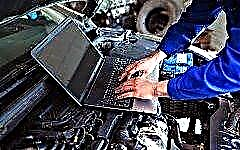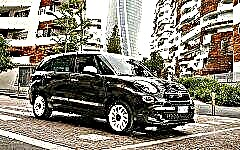
Checking the body is important both in the process of purchasing a vehicle, and subsequently for long-term operation. How to check one of the most expensive car parts yourself?
Why body inspection is important

There are 3 main sores in the car body: rust, poor geometry and problems with paintwork. It is with them that experts recommend starting an audit of the technical condition of any machine and only then moving on to the engine, chassis and other elements.
Although all modern models are still treated with anti-corrosion agents at the factory, after 3-5 years, rust spots may appear due to high humidity, large temperature differences, mechanical damage to the paintwork, the negative effect of chemical reagents on the metal, as well as operating conditions.
When rust appears on the attachments, they can be dismantled and replaced with new ones. If it struck the wheel arches, sills, openings, roof, the car owner should prepare for serious difficulties. Due to the presence of internal cavities, often difficult to access and capable of retaining moisture, corrosion will safely corrode the metal, unnoticed by the driver.
This process can be detected by small bubbles on the paintwork, indicating such a large area of rust that it will begin to look for a way out. If the factory has poorly applied anti-corrosion coating or has not treated the damaged area after repairs, rust can cause serious damage to the body.
Geometry check

Car enthusiasts primarily monitor the condition of the power unit and chassis, although they can always be replaced or repaired, albeit at great expense. Whereas incorrect body geometry, rust, kinks are very difficult to correct, can lead to an emergency and other troubles:
- An unstable trajectory, when the machine pulls perceptibly to the left or right, vibration in the steering rack can be felt.
- Strengthening tire wear, which will become uneven, as well as increasing fuel consumption due to the impossibility of making similar camber by setting the wheels at the right angles.
- Damage to the metal structure in the event of an accident will not allow the driver and his passengers to be saved, since due to violations it will literally "fold like a house of cards."
To detect problems with body geometry, there are several important rules to be aware of:
- Cleanliness and good lighting. To see all potential defects, the body must be cleaned of dirt and dust, and the inspection itself must be carried out either in daylight, or simply with very high-quality lighting.
- Using a thickness gauge. After an external examination, it is recommended to use a device that measures the thickness of the paintwork, which can be magnetic, ultrasonic, electromagnetic and eddy current. The first are the most budgetary devices, with a magnet placed inside, whose force of attraction to the metal varies depending on the thickness of the paintwork. The degree of deviation of the arrow of the device will show the amount of paint put in one place or another of the body.
Electromagnetic specimens have proven to be more reliable and accurate, and therefore more expensive, but they measure only paintwork on iron and do not work with plastic or non-ferrous metal.
It is recommended to start the check from the roof of the car, which is least likely to be damaged, and therefore can be considered practically a reference for measuring paintwork. The next ones to be inspected are the rear fenders for possible cutting of the wing and damage to the stiffener.
In the event of a strong impact, it is not cost-effective to stretch and repaint some of the fenders, while the most rational solution would be to replace them with a new element painted to match the body color.
The wing arches, which are most exposed to external influences, deserve close attention, and if there are signs of removing the gas tank flap, you can almost certainly be sure that there are painted parts on the body.
The luggage compartment lid should be checked for tightness of the fastening bolts, which should not be damaged or be of a color different from the body. Otherwise, the torn off splines will indicate the dismantling of the cover for the purpose of body repair.
Looking for a sealant

At the car manufacturer, a layer of sealant is applied automatically, with a recognizable seam, covering all body parts. If the body has undergone some damage and subsequent repairs, it will be impossible to repeat such a seam. The sealant applied independently or in a car service is easily detected by pressing on it and the appearance of traces of paint from under the layer.
Likewise, it is recommended to inspect the luggage compartment, including removing the carpet and spare wheel. The sealant around the perimeter of the floor should be free of cracks and repairs, which are often tried to be masked with guerlain or mastic.
Especially the floor of the trunk, covered only in separate fragments, and not entirely over the entire area, should be in doubt, which will clearly show an attempt to hide the traces of repair.
The hood and doors are also examined, traces of dismantling on which serve as an indicator of the repair carried out. The paintwork of the doors can also be measured with a thickness gauge, then check the fastening bolts and hinges, and then pay attention to the type of sealant.
A number of factories leave a control smear on the fasteners of the body, which differs from the body in color. When replacing some part of the body, the driver will not find such a mark, or, due to the ignorance of the repairmen, it will be matched to the body color.
Power structure and hood

B-pillars, sills and interior arches directly affect the geometry of the car body, being a component of the load-bearing structure. In case of a side impact, it is on the rack that the main load falls, therefore, in the presence of defects, repairs, non-factory seams, it will not fully fulfill its purpose and can lead to death in the event of an accident.
Another place to check doorways is the space under the rubber seal where the factory spot welding should be visible. Its absence also means repair work.
The hood, like other elements, must have reliable fasteners, a layer of sealant, and no foci of corrosion. Cheap or low-quality models of the Chinese car industry are primarily determined by smeared sealant or no sealant at all.
In general, the presence of chips, scratches, traces of repair on the hood can be called a frequent phenomenon, since this part is most in contact with the external environment. The main thing that the owner should check is that there is no violation of the geometry, which can cause poor handling of the car.
Hood space, bumpers and VIN number

The shock absorber strut mountings, referred to by drivers as “cups,” must also be stamped, spot welded and factory-applied with a reinforced sealant layer.
The most important is a thorough examination of the side members related to the body structure, which should not be bent, have defects and creases.
The car VIN number, usually located under the hood, on the pillar of the driver's door or under the seat, should not bear traces of painting, hardly recognizable characters, dirt under the varnish layer. Otherwise, when buying and selling a car, the traffic police inspector may doubt the legality of the identification marking and send the car for examination.
The last step in checking the body will be bumpers, which are more likely to be exposed to external influences than other elements. It will not be possible to check the plastic with a thickness gauge, so a visual inspection of the end parts should be carried out. They will become the best indicator, since in the process of repair work, rare car service masters are taken to such places. And, therefore, it is there that you can find paint streaks, a color difference, a spraying signaling about painting the body.
Conclusion
Before buying, selling or as part of a technical inspection of a car, it is imperative to check the condition of the body. Any most modern, most technologically advanced model is subject to various external factors, deformations, damage, and also does not exclude human errors even at the assembly stage.
Uneven paintwork, poor geometry, or a missing area when treating with anti-corrosion agents can subsequently lead to additional troubleshooting costs.

|| list |
- Why body inspection is important
- Geometry check
- Looking for a sealant
- Power structure and hood
- Hood space, bumpers and VIN number











